Catch nature’s most dramatic performances during those fleeting moments between seasons. When summer softens into fall, or winter reluctantly yields to spring, Ontario’s landscapes transform into living art galleries that photographers and nature lovers dream about. These transitional periods – lasting mere weeks – offer extraordinary opportunities to witness dawn mists rising over golden marshlands, crystalline frost decorating autumn’s last leaves, and the first wild trilliums pushing through melting snow.
These in-between seasons tell the most compelling stories in our parks. It’s when you’ll spot migrating birds resting in unusual places, capture ethereal morning light that only exists during these seasonal shifts, and experience the raw energy of nature in flux. While tourists flock to parks during peak seasons, these threshold moments belong to the patient observer, rewarding those who venture out during nature’s costume changes with unique photography opportunities and solitary trails.
For the mindful explorer, these transitional periods offer more than just stunning visuals – they’re windows into the delicate rhythm of our ecosystems, revealing how wildlife adapts and landscapes evolve. Pack your camera, dress in layers, and prepare to witness Ontario’s parks at their most dynamic and photogenic.
When Winter Softens into Spring
Ice-Break Photography
The breaking of winter’s icy grip offers photographers a fleeting but spectacular opportunity to capture nature’s dramatic transformation. As Ontario’s lakes begin their spring thaw, the ice creates an ever-changing canvas of textures, patterns, and reflections that can result in truly unique photographs.
For the best ice-break shots, timing is everything. Plan your visit during the early morning hours when the light is soft and the wind is typically calmer. Listen for the telltale sounds of cracking ice – these auditory cues often signal where the most dramatic scenes will unfold.
Safety first: Always shoot from a safe distance on solid ground. Never venture onto thawing ice, no matter how tempting the shot might be. A telephoto lens (200mm or longer) will help you capture detailed shots of breaking ice while maintaining a safe position.
Look for contrasting elements in your composition – dark water against white ice, or the golden light of sunrise reflecting off jagged ice sheets. The abstract patterns created by melting ice can make for compelling minimalist photographs, while wider shots capturing ice floes against the shoreline tell the broader story of seasonal change.
Some of the best locations for ice-break photography include the shorelines of Georgian Bay, where massive ice sheets create dramatic scenes, and smaller inland lakes where you can safely observe the entire thawing process from shore. Remember to protect your gear from moisture and bring extra batteries – cold conditions can drain them quickly.
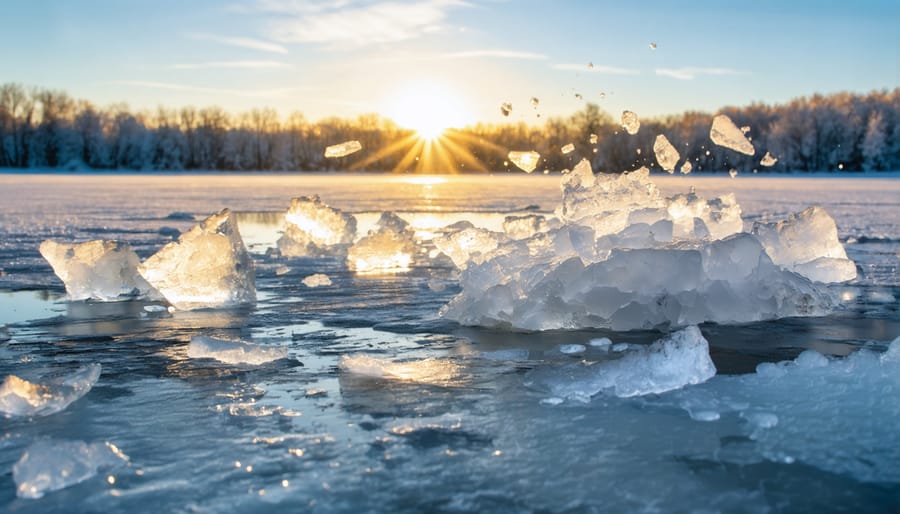
First Signs of Life
As winter’s grip begins to loosen, nature treats us to a spectacular show of renewal. The first signs often appear in unexpected places – tiny snowdrops pushing through melting snow, or the distinct call of chickadees changing from their winter “dee-dee-dee” to their spring “fee-bee” song. For nature enthusiasts and photographers, these subtle changes signal prime opportunities for capturing Ontario’s awakening landscape.
Keep your eyes peeled for early-blooming wildflowers like trilliums and hepatica in deciduous forests, particularly in protected southern slopes where snow melts first. These delicate blooms make perfect subjects for macro photography, especially during the golden hours of early morning when dew drops add extra sparkle to your shots.
The return of migratory birds offers excellent opportunities for photographing returning wildlife. Red-winged blackbirds are among the first to arrive, followed by turkey vultures and various waterfowl. Listen for spring peepers in wetland areas – these tiny frogs create nature’s first symphony of the season.
Pro tip: Pack a waterproof ground sheet and knee pads for low-angle shots of emerging plants. Early spring soil can be quite muddy, and getting down to eye-level with these small subjects will dramatically improve your photos. Remember to tread carefully around new growth and stick to marked trails to protect these vulnerable early-season species.
Summer’s Golden Farewell
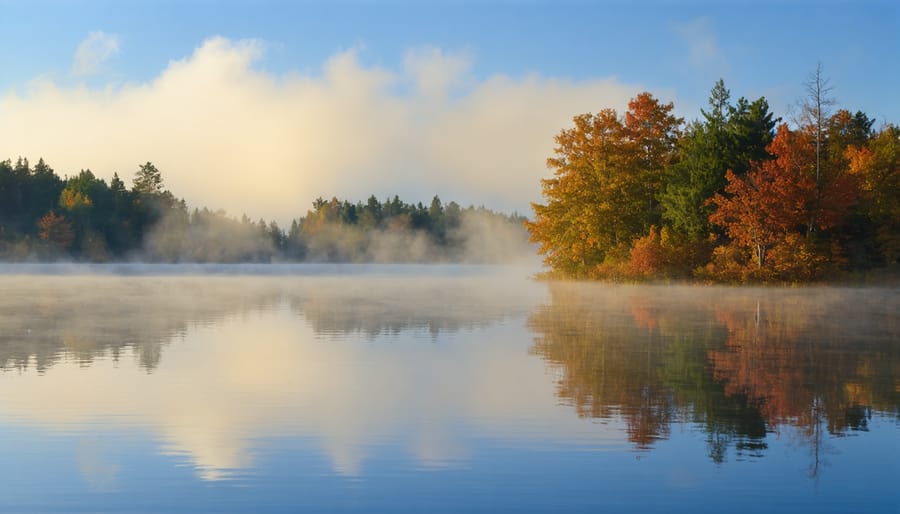
Early Morning Mist Magic
There’s something magical about watching tendrils of mist dance across an Ontario lake at dawn. During spring and fall transitions, these ethereal morning shows are at their most spectacular, creating perfect conditions for photographers and nature enthusiasts alike.
The best time to catch this natural phenomenon is just before and after sunrise, when cool night air meets warmer water surfaces. Pack your gear the night before and arrive at your chosen spot while it’s still dark. Lakes, wetlands, and low-lying meadows offer prime viewing locations, with spots like Algonquin’s Lake of Two Rivers and Killbear’s Georgian Bay shoreline being particular favorites.
For photographers, bring a tripod to handle longer exposure times in the dim light. Wide-angle lenses help capture the expansive mood, while telephoto lenses can isolate interesting patterns in the mist. Consider including silhouettes of trees or wildlife to add depth to your compositions.
Remember to dress in warm, waterproof layers – those misty mornings can be surprisingly chilly. Bring a thermos of hot coffee or tea to keep yourself comfortable while waiting for the perfect shot. Most importantly, give yourself time to simply observe. Sometimes the most memorable moments come when you put the camera down and watch nature’s morning show unfold.
Be mindful of your surroundings and avoid disturbing wildlife that may be active during these early hours. Their morning routines are just as important as your photography goals.
The First Touch of Fall
As August winds down, nature whispers its first hints of autumn’s approach. The key to capturing these early fall color changes lies in knowing where to look and when to venture out. Start by monitoring maple trees, particularly those along forest edges or in stressed conditions, as they’re often the first to transform. Early morning light creates magical opportunities to photograph these initial splashes of color against the still-dominant green backdrop.
Keep an eye on higher elevations and north-facing slopes, where cooler temperatures trigger earlier color transitions. The Lookout Trail at Algonquin Park and the Bruce Peninsula’s escarpment edges are perfect spots to witness these first signs of fall. For the best photos, bring a polarizing filter to enhance the contrast between emerging yellows and fading greens.
Pro tip: Download Ontario Parks’ fall color report app to track the progression across different regions. Consider visiting mid-week when trails are quieter, allowing for unrushed composition setup. Look for subtle details too – the crimson blush of poison ivy, the golden edges of birch leaves, or the deep purple of wild grape vines. These often-overlooked elements can create stunning macro photographs that tell the story of summer’s gentle farewell.
Remember to tread lightly and stick to marked trails – protecting these delicate transitional ecosystems ensures future photographers can capture their own perfect autumn moments.
Essential Gear and Planning
Weather-Ready Equipment
Being prepared for Ontario’s changeable transitional seasons means having the right gear on hand. Start with a reliable layering system: a moisture-wicking base layer, insulating mid-layer, and waterproof outer shell that you can add or remove as conditions shift. Pack a compact emergency poncho for unexpected downpours.
Don’t forget your weather-protected camera gear to capture those stunning seasonal transitions. A sturdy pair of waterproof hiking boots with good traction is essential, as trails can quickly become muddy or slippery. Bring moisture-wicking socks and a spare pair to keep your feet dry and comfortable.
Consider investing in convertible hiking pants that zip off into shorts, perfect for those days that start cool but warm up significantly. A lightweight, packable down jacket provides warmth without bulk when temperatures drop. Don’t forget accessories like a waterproof dry bag to protect electronics and a reliable headlamp for shorter daylight hours.
Pro tip: Pack fingerless gloves with mitten covers – they’re perfect for those chilly mornings that turn into warm afternoons. A thermos for hot beverages and a good-quality reusable water bottle will keep you hydrated in any weather. Remember to bring a small microfiber towel to dry off equipment or wipe down wet surfaces before settling in for that perfect nature shot.

Best Times and Locations
Ontario’s transitional seasons offer spectacular viewing opportunities, particularly during the “golden hours” – just after sunrise and before sunset. For spring enthusiasts, Algonquin Park’s western trails come alive in late April to early May, when the first wildflowers peek through melting snow and migrating birds return to their breeding grounds.
The Bruce Peninsula is magical during fall’s peak, typically mid-October, when the ancient cedars contrast beautifully with the changing deciduous trees. For the best fall colors, time your visit between 10 AM and 2 PM when the sun is high enough to illuminate the canopy but not too harsh for photos.
Killarney Provincial Park offers stunning vistas during both seasons, with the white quartzite ridges of the La Cloche Mountains providing a dramatic backdrop. Visit on partly cloudy days for the most dynamic lighting conditions – the moving clouds create ever-changing patterns on the landscape.
Lesser-known gems include Frontenac Provincial Park, where early morning mist rises from hidden lakes during spring thaw, and Bon Echo Provincial Park, where fall colors reflect perfectly in the still waters of Mazinaw Lake. For photographers, these locations are best visited mid-week to avoid crowds.
Remember to check park opening hours seasonally, as they vary throughout the year. Many parks offer extended hours during peak color seasons, giving you extra time to capture those magical transitional moments.
Responsible Photography Tips
Leave No Trace Photography
Capturing the beauty of transitional seasons requires not just technical skill, but also a deep respect for the natural environment. Following Leave No Trace principles ensures that future photographers can enjoy these fleeting moments just as you did.
Stay on marked trails when seeking that perfect shot – wandering off-path can damage delicate vegetation emerging in spring or late-blooming fall flowers. When photographing wildlife, maintain a safe distance and use longer lenses rather than approaching too closely. Remember, stress on animals during these challenging seasonal changes can impact their survival.
Consider timing your visits during off-peak hours to minimize your impact. Early morning and late afternoon not only offer the best light but also tend to be quieter times in the parks. Pack out everything you bring in, including seemingly harmless items like fallen leaves or pine cones you might be tempted to rearrange for your composition.
Keep your footprint light by staying in designated areas for sunrise and sunset shots. If you’re planning night photography during these darker seasons, use red lights to minimize disruption to nocturnal wildlife. And while it’s tempting to grab that perfect social media shot, avoid geo-tagging sensitive locations that might become overwhelmed with visitors.
Remember, the best images often come from patience and respect for the environment you’re capturing.
Supporting Local Conservation
As photographers, we have a unique opportunity to support the conservation efforts that keep Ontario’s parks beautiful during these transitional seasons. Consider purchasing an annual park pass – it’s not just convenient for your photography adventures, but the proceeds help fund vital conservation programs. Many parks also offer photography permits, with fees directly supporting park maintenance and wildlife protection initiatives.
Share your stunning transitional season photographs with Ontario Parks through their social media channels or photo contests. These images help raise awareness about the delicate beauty of these in-between seasons and inspire others to appreciate and protect these natural spaces. Remember to tag your locations responsibly to prevent overcrowding at sensitive areas.
Join local conservation groups or “Friends of” park organizations that organize cleanup events and habitat restoration projects. These hands-on experiences not only give you unique photography opportunities but also help preserve the landscapes you love to capture. Many parks also welcome volunteer photographers to document their conservation efforts and seasonal changes.
Always practice “leave no trace” principles while shooting. Stay on marked trails, maintain a safe distance from wildlife, and avoid disturbing natural features for the perfect shot. Consider leading photography walks that educate others about responsible nature photography, or donate prints to park fundraising events. Every small action helps ensure these magical transitional moments remain pristine for future generations to photograph and enjoy.
As we wrap up our journey through Ontario’s transitional seasons, it’s clear these in-between periods offer some of nature’s most enchanting moments. Whether you’re watching spring’s first trillium peek through melting snow or catching autumn’s early frost painting leaves in brilliant hues, these fleeting transitions hold a special magic that can’t be found during peak seasons.
These periods of change invite us to slow down and notice the subtle shifts in our natural world. From the morning mist rising over still-warm lakes in early fall to the first chorus of spring peepers breaking winter’s silence, each day brings new discoveries for those willing to pause and observe.
Beyond their natural beauty, transitional seasons offer practical advantages too. You’ll find fewer crowds on trails, more flexibility with accommodations, and often better rates for seasonal activities. Wildlife viewing opportunities abound as animals prepare for the coming season, making these periods particularly rewarding for photographers and nature enthusiasts.
Remember to pack layers, check weather forecasts, and remain flexible with your plans – nature’s transitions don’t always follow our calendars. But that unpredictability is part of the adventure, creating unique experiences that might just become your most treasured outdoor memories.
So next time you’re planning an Ontario outdoor adventure, consider choosing these magical in-between times. The transitional seasons remind us that change itself is beautiful, and sometimes the journey between destinations offers the most remarkable views.

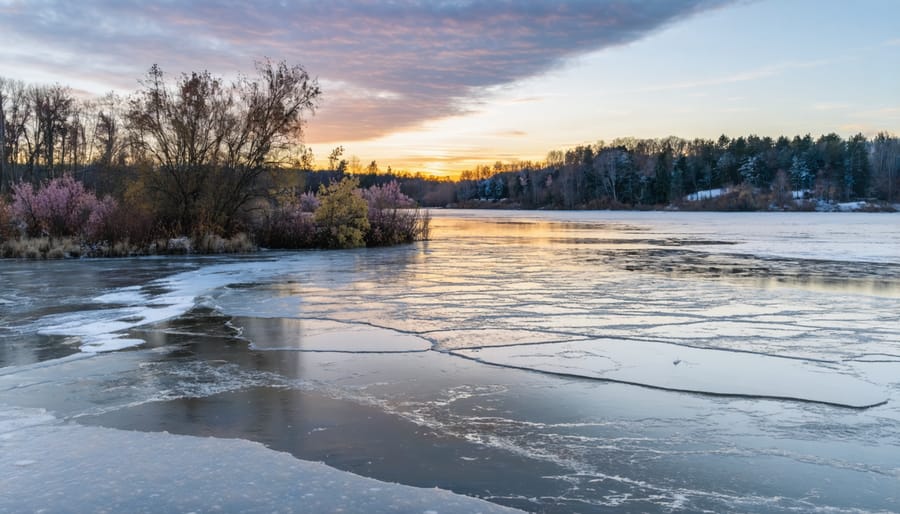
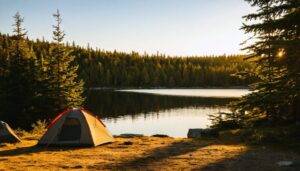
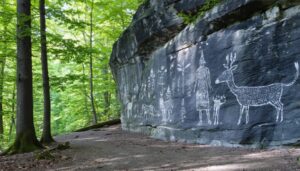




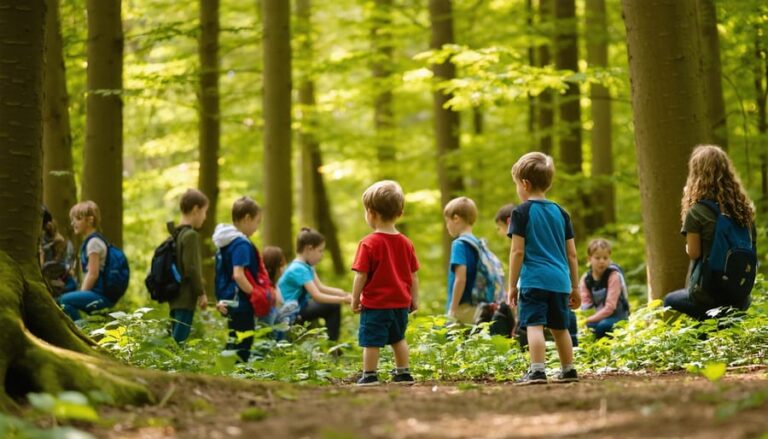
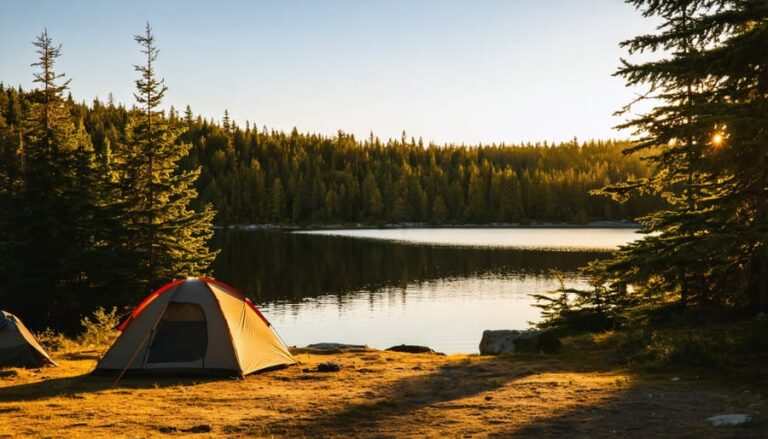
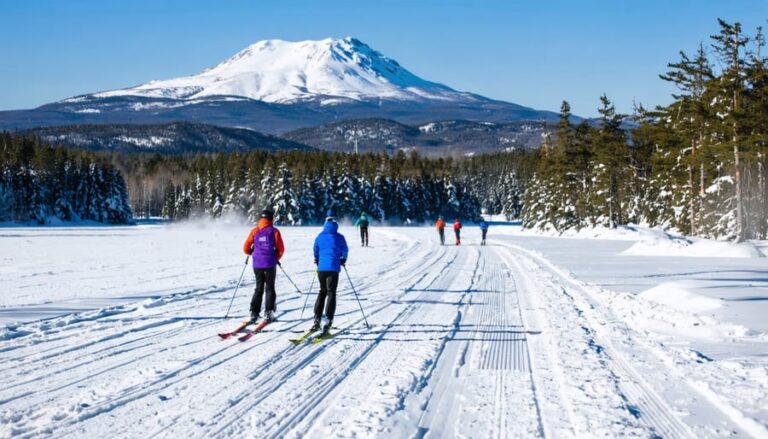

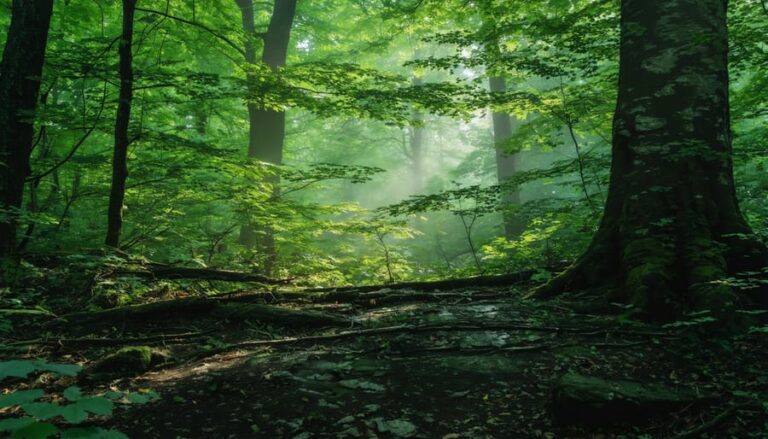
+ There are no comments
Add yours